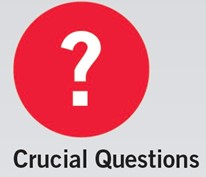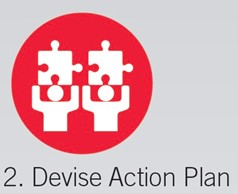Management: Think Red Flags: A Proactive And Profitable Approach For Your Small Business

This article is an excerpt from Think Red Flags, a 210-page book published in May by Walter Hill, Jr. An accomplished businessman, Hill was CEO of Los Angeles-based distributor Icon Blue from 1998 through its merger with distributor PromoShop in 2018. Read more about Hill below.
It hit us one day like a proverbial ton of bricks. Although we had thousands of competitors in the promotions industry, many of them much larger than us, very few businesses had achieved the levels of efficiency and profit that we had attained. Even companies far bigger than us could not match our performance or profitability. And so, we asked ourselves the obvious question: “What makes the difference?” The answer came back quickly: Our Red Flag approach gives us a huge edge.
We knew almost from the beginning that Icon Blue was onto something important with Red Flagging. We also recognized that if you’re doing something that works, keep doing it. Countless times in the promotions business, we had incidents where Red Flagging became crucial to our success.
“But will it work in my industry?” someone asks. “We don’t do promotions; we make educational apps. How could Red Flagging work for us?”
The Red Flag approach is not a rigid system so much as a focused way of thinking. Think of it as systematic mindfulness trained in a certain direction, not a rigid 1-2-3 step system that must be followed in order. Anyone can learn and grasp its processes and then apply them in appropriate and potent ways to their own business for better performance and profitability.
Regardless of your own industry sector, what important tasks must you efficiently get done to achieve your goal? These are your Red Flags.
![]()
To better understand what Red Flagging can do for you, make a list of all the reasons why you want to start a business (or are operating the business you currently lead). Take a few minutes to compile your list, then come back and continue reading. Of the reasons you just listed for starting or operating a business, which of the following did you include?
- Make a profit
- Provide customers with services or products that represent real value
- Provide secure employment and future opportunities for staff
- Achieve financial success for myself and my team
- Become an asset to my community
- Share the benefits of my success with the less fortunate
- Gain more control over my own destiny
Unless you are highly unusual, I expect that more than one of the reasons named above made it onto your list. And if they did, then your next question should be, “How do I achieve these things?”
To find good answers to the key issues you face in business, first you need to ask the right questions. Red Flagging goes far beyond identifying and avoiding potential problems in your business. It also involves developing a matrix to establish clear guidelines for what you need to do to avoid a problem and accomplish your goals. You need to address key elements of your business process, and it’s not terribly difficult to identify the key aspects of your business that you must manage well.
Red Flagging is not complicated; in fact, it is so simple that we find it very easy to overlook potential pain points. Every entrepreneur must adjust to a unique set of circumstances and factors specific to their business. Those circumstances are Red Flags, some of which can cause more damage than others.
As a business owner, you may believe that everything about your business is important to your success. You should be able, however, to narrow down “everything” to a few critical areas. Again, the Red Flag approach teaches a process of analytical thinking. It does not provide a four- or five-step system to execute all tasks. My overall business plan had its own Red Flags and my overseas import process had a different set of caution points. I could not, in good conscience, make the claim that one size fits all; but here are a few thoughts to help you get started. Let’s use the construction supply business in Chapter 13 as an example.
––––––––––––––––––––––––––––––––––––––––––––––––––––––––––––––––––––––––––

- A thought process designed to help substantially reduce a company’s error rate
- An approach, not a system
- Methodical mindfulness
- A habit of critical thinking
- A pattern of anticipation and strategic planning to address key problems, thus equipping a business to thrive
- A way to identify key problem areas in a business and create a plan to avoid them, or at minimum significantly diminish their impact
- Intuition + Foresight = Red Flagging

- What can we do to reduce the impact of problematic issues in our business, or even eliminate them altogether?
- How can we sift out likely business challenges and forecast ways to overcome them?
- What could go wrong here, despite our comprehensive plan? What did we miss?
- How could we respond if Really Bad Thing X happened?
––––––––––––––––––––––––––––––––––––––––––––––––––––––––––––––––––––––––––

1. Assess Situation
- A. What tasks are critical to our success?
- B. What foreseeable issues related to these key tasks could prevent us from succeeding?
- C. Since not every issue requires a Red Flag, what kind of issues are we considering?
- Low Impact – Does not require a Red Flag
- Moderate Impact – Might require a Red Flag
- High Impact – Requires a Red Flag

- A. What steps can we take now to avoid committing errors related to the issues named above?
- B. What plan can we put in place to reduce the impact of committing any errors related to the issues identified above?

- A. Highlight all critical action items with a Red Flag.
Create a Matrix to execute our operations so that we can efficiently achieve our objectives—a written to-do list of daily tasks to perform designed to create and retain satisfied customers.
If necessary, create an Advanced Matrix to address significant “What if” scenarios: What will we do if X happens?
- B. Intentionally execute all Red Flag action items in an ongoing manner.
- C. Train our team in this Red Flag approach and get their buy-in.
- D. Deliver what we promise.
––––––––––––––––––––––––––––––––––––––––––––––––––––––––––––––––––––––––––
![]()
Identify the areas in your business that are crucial to your success. The construction supply business owner, for example, needed the right suppliers to provide quality products for his customers. Without that, he cannot sustain a customer base.
![]()
List the important, specific tasks within the crucial areas identified in Phase One (i.e., supply chain development strategy).
![]()
Create action items from the tasks listed in Phase Two. The construction supply business owner knew that his industry had a reputation for late deliveries that resulted in costly construction delays. He therefore took action to create a differentiator that distinguished his business from the competition—a strategy to deliver quality products on time and at competitive pricing. Not only was this the right approach to encourage repeat customers, but it also created a great sales feature for his sales team. This one action proactively prevented a problem common within his industry.
![]()
Execute with intentionality. Prioritize your tasks, monitor your results and keep score. Some Red Flags can be documented as a part of your operating matrix. Others can be managed with a mental note by your team.
Train your team in this approach and get each team member to buy into it. Execution is everything; you must always deliver whatever you promise. And how can you do that if your team doesn’t buy into your service commitment?
––––––––––––––––––––––––––––––––––––––––––––––––––––––––––––––––––––––––––
Think Red Flags: A Proactive and Profitable Approach For Your Small Business is available on Amazon in paperback and as a Kindle e-book.
Walter Hill Jr. is a second generation entrepreneur from Petersburg, Virginia, where his father owned three small businesses. After working with his father and attending the University of Maryland, Hill moved to Los Angeles, where he became a notable leader in the brand marketing industry. He founded distributor Icon Blue in 1998, and within its first few years of operation, the company earned the Macy’s Star Supplier Award and American Honda Motor’s Tier One Supplier Award. His business achievements have been noted by The Wall Street Journal, Advertising Age, Counselor, Advantages and other magazines. He is the recipient of Counselor’s Marvin Spike Lifetime Achievement Award and the Greater Los Angeles African American Chamber of Commerce Lifetime Achievement Award. In 2017, Icon Blue was named one of PPB’s Greatest Companies To Work For. Hill has served on the boards of the Los Angeles Chamber of Commerce, the Greater Los Angeles African American Chamber of Commerce, The Mattel Children’s Hospital Board at UCLA, and The Eras Center, a school for children with learning disabilities.

